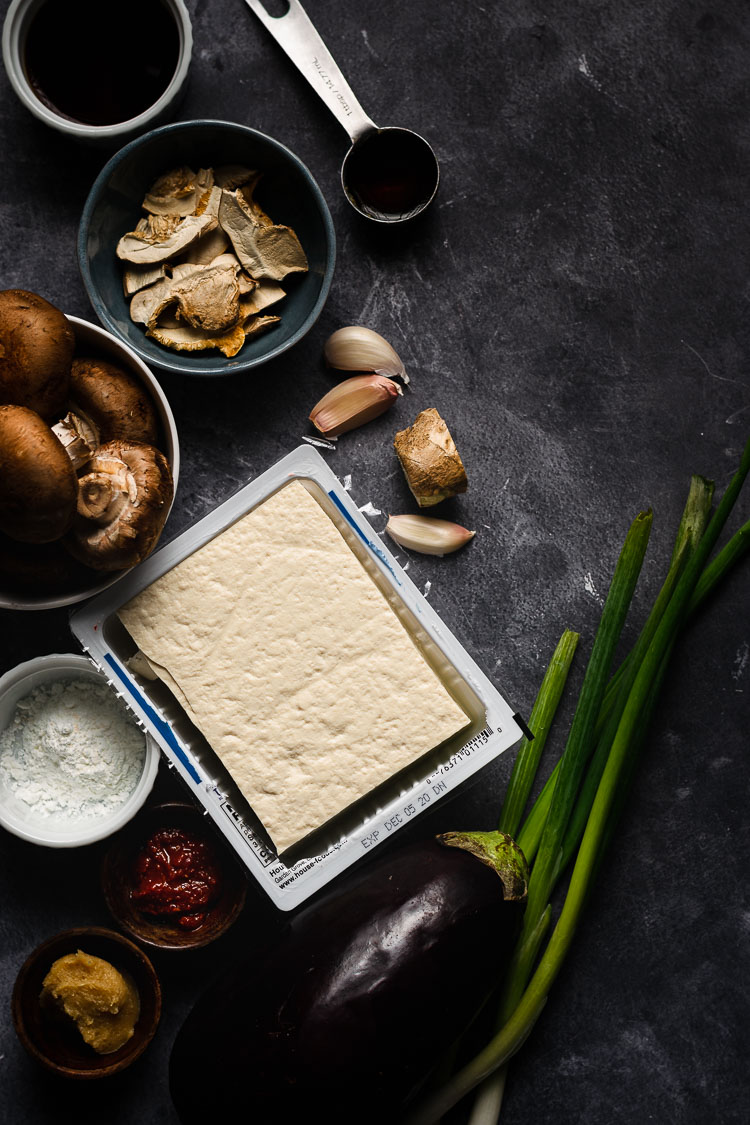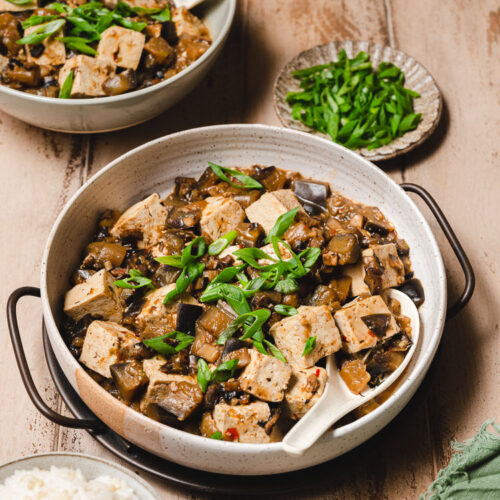Vegan Mapo Tofu (Japanese-Style) | ヴィーガン麻婆豆腐
Japanese-style mapo tofu made without any meat! Tofu, mushrooms, and eggplant simmered in a spicy, flavorful, umami-rich sauce.

This is not your typical mapo tofu recipe. For one, it’s vegan so it doesn’t contain any meat. It’s also based off the Japanese-style mapo tofu, so it isn’t as spicy or mouth-numbing as its Chinese counterpart. However, it is still rich and flavorful, and (warning) may cause you to eat an extra bowl or two of rice. I haven’t had mapo tofu since switching to a plant-based diet 5 years ago, so I am so happy to be able to eat one of my childhood favorites again (modified to my tastes of course)! And of course I can’t wait to share the recipe with you, so let’s dive in.

What is Mapo Tofu?
For those of you who don’t know what mapo tofu is or have never eaten it before, it’s a popular Sichuan dish consisting of tofu coated with a spicy, oily sauce that’s also cooked with ground pork or beef. The original Chinese version uses a very spicy red sauce along with Sichuan peppercorns for even more spice. You definitely want to serve it with rice to cut the spiciness and enjoy the flavors more.
Mapo tofu is also very popular in Japan, and many home cooks have tweaked the recipe to suit Japanese tastes and ingredients. For Japanese-style mapo tofu, the peppercorns are left out and the only spice comes from doubanjiang (chili bean paste). The flavor is much more mild and suitable for most children.

Ingredients
- Tofu ⟶ medium firm, silken/soft, or a combination of both
- Eggplant ⟶ Since we’re chopping the eggplant, American globe eggplants work fine. If you want to make this with large slices of eggplant, use a Chinese or Japanese eggplant.
- Mushrooms ⟶ I usually use white button mushrooms or crimini mushrooms since they are readily available and affordable where I live. Shiitake are also a great, flavorful addition — I usually use dried shiitake, rehydrate them, and use the leftover liquid for the sauce.
- Garlic, Ginger, & Green Onions ⟶ for extra flavor
- Spicy Doubanjiang* ⟶ A Chinese fermented broad bean paste mixed with chili peppers. Make sure you get the spicy Doubanjiang (called La Doubanjiang 辣豆瓣酱 in Chinese) as this is where all the heat comes from in this recipe.
- Vegetarian Oyster Sauce ⟶ made from mushrooms instead for that umami punch (can omit and replace with more soy sauce if necessary)
- Red Miso, Soy Sauce, & Sake ⟶ Japanese ingredients that make the sauce more mild but still rich and flavorful
- Cornstarch ⟶ to thicken the sauce
- Oil ⟶ a neutral cooking oil (canola, grapeseed, vegetable) and sesame oil added at the end for flavor

Japanese Mapo Tofu FAQ

More Hearty Japanese Dishes!
- White Bean Korokke | 豆入りコロッケ
- Tofu & Eggplant Ginger Stir Fry | 豆腐の生姜焼き
- Chili Sauce Tofu & Broccoli | 豆腐とブロッコリーのチリソース
- Vegan Hayashi Rice | ヴィーガンハヤシライス
- Japanese Curry with Red Lentils | レンズ豆入り自家製カレー
- One-Pot Spicy Miso Ramen | 辛味噌ラーメン
- Tofu Gyoza | 豆腐餃子

I hope I’ve inspired you to make this vegan mapo tofu! If you try it out, don’t forget to tag me in your photos on instagram @ellielikes.cooking, leave a comment/rating down below, and let me know how you liked it! I love seeing all of your tasty recreations 🙂 Happy cooking! ♡
Vegan Mapo Tofu (Japanese-Style)

Ingredients
- 16 oz medium firm tofu2 cubed
- 2 tbsp neutral cooking oil
- 3 cloves of garlic minced
- 1 inch knob of ginger minced
- 3 green onions chopped, whites and greens separated
- 4 oz shiitake mushrooms1 chopped
- 1 Japanese eggplant chopped
- 2 tsp cornstarch
- 2 tbsp water
Japanese sansho pepper* optional
Seasonings
- 2 small dried shiitake
- ¾ cup (180ml) water
- 1 tbsp red miso
- 2 tsp sake
- 2 tsp
soy sauce* or tamari for gluten-free - 1 tbsp
vegetarian oyster sauce*3 - 1-3 tsp
spicy doubanjiang* adjust to taste - 2 tsp
sesame oil*
Instructions
- Rehydrate dried shiitake: Add dried shiitake and water to a bowl and set aside for a couple hours to rehydrate the shiitake. If you're short on time, use hot boiling water.
- Boil tofu (optional): Add tofu to a small pot with water and bring to a boil. Boil for 1 minute, then drain and set aside. Tip: You can skip this step if you're short on time, but it makes the tofu more flavorful and hold together better.
- Prep dried shiitake: Set a sieve over a bowl and pour the shiitake in. Squeeze the water out of the rehydrated shiitake and add to the soaking water. Save this water! Chop the shiitake and set aside with the other mushrooms.
- Mix seasonings: To the bowl with the leftover shiitake water, add remaining seasonings (miso, sake, soy sauce, vegetarian oyster sauce, spicy doubanjiang, and sesame oil). Mix well and set aside.
- Stir fry aromatics, eggplant, and mushrooms: Heat oil in a deep pan or wok over medium heat. Add garlic, ginger, and the white parts of the green onions. Once fragrant (about 30-60 seconds), add eggplant and mushrooms. Cook until the mushrooms have released their liquid and the eggplant is tender.
- Add tofu and seasonings: Add tofu and pour in the seasonings. Gently stir so everything is well combined. Simmer for about 2 minutes so tofu heats through.
- Thicken with starch slurry: Dissolve cornstarch in 2 tbsp water to make a slurry. Add the slurry and stir to incorporate. Once the sauce thickens, turn off the heat. Top with the green parts of the green onions. Sprinkle sansho on top if using and serve immediately.
Notes

*Disclosure: This page may contain affiliate links. As an Amazon Associate I earn from qualifying purchases, but the price remains the same to you. Thank you for supporting Ellie Likes Cooking!
Save for later!







